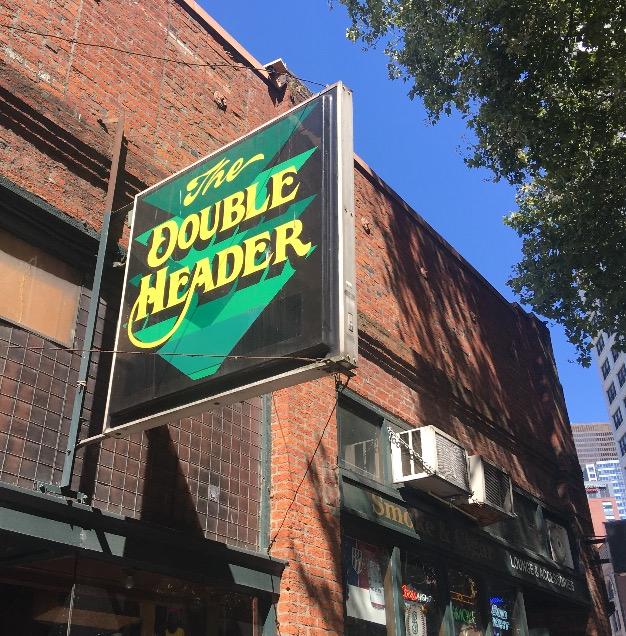ReImagining the PhD Project

Pioneer Square and the Making of Queer Seattle
Project Description
“Pioneer Square and the Making of Queer Seattle” is a public project that transforms a walking tour of the Pioneer Square neighborhood—originally created by The Northwest Lesbian and Gay History Museum Project (NWGLHMP)—into a digital project. The original tour introduced patrons to the vibrant, queer world in Pioneer Square that existed well before the 1970s. In 2017, I received a Mellon Summer Fellowship for Public Projects in the Humanities to translate the tour into a digital story map using ArcGIS StoryMaps, a user-friendly platform that requires minimal knowledge of GIS. I focused on developing the map’s text and images, which required archival work in the University of Washington Libraries Special Collections. The photographs and other ephemera of queer history can be difficult to find, and this project was no exception. For some sites on the tour, no visual material existed, and contemporary photographs of the locations had to be used. This challenge informed my workflow: I began by drafting the text for each site based on the existing historical record. From there, I made efforts to find related photographs and other ephemera in the archives. Though the summer fellowship has ended and the project has launched, I still update the text and add photos and other materials as I find them—most often accidently—in the archives.
The question of audience for the story map is interesting, as it has changed over time. When the project began, I had one potential community partner in the National Park Service (NPS). However, with the election of Donald Trump in 2016, the NPS’s engagement with the project became more limited. Yet through public presentations at the Northwest Historians Guild and connections at the University of Washington, more people became aware of the project, and somewhat paradoxically, this increased awareness cultivated a renewed interest in the walking tour itself. Since the beginning of the project, I have given the tour to various organizations and groups including the Museum of History and Industry (MOHAI), the Pacific Northwest Historians Guild, Klondike Gold Rush National Park, and Historic Seattle, among others. Through this work, I’ve gained a deeper appreciation of place-based history: the intersections between the physical spaces themselves and the queer history that unfolded there, which is largely invisible in Pioneer Square today. And with this appreciation, I’ve become increasingly aware that this project matters not just to me but to many people of various backgrounds and identities.
How have your engagements with public scholarship shaped your research?
The connection of “Pioneer Square and the Making of Queer Seattle” to my dissertation has evolved over time. After doing some preliminary work, Pioneer Square became the catalyst historical site for my dissertation research and research analysis. It’s important to note that while the localization and periodization of the public project and the dissertation is the same, each has a different focus. The walking tour and story map is inclusive of the entire queer community, while the dissertation research is focused on queer and lesbian women. Early on, I felt some disconnection from my dissertation study site, as Seattle is not my hometown. However, in 2016, I began work on the walking tour, and this work ultimately enriched my dissertation project. I originally aimed to write a traditional dissertation modeled on a monograph manuscript, which would have included some discussion of the public project during my methods section. However, in part because I wanted to elevate the project and show how public scholarship might advance a larger research agenda, I decided to switch from a manuscript format to a three-paper dissertation. One of the papers is about “Pioneer Square and the Making of Queer Seattle” and centrally discusses how scholars can better incorporate public scholarship in academic research.
How might doctoral education be reimagined/changed?
Doctoral education needs to embrace public scholarship as valid research—and for graduate students, this means allowing this work to be integrated into the dissertation. Public scholarship is fulfilling and taps into different skill sets that can only enhance our professional training. Unfortunately, until I switched to a three-paper option for my dissertation, the project felt like a footnote to my “real research”—but from my perspective, it was so much more, and played a generative role in the questions and connections that shaped my dissertation work. Fortunately, my department (Geography) offers a three-paper option, so I was able to center my public-facing work in one of the papers. But not every department allows dissertations to be inclusive of public scholarship. At most, these projects “count” as one of three papers or a chapter of a dissertation. Even in more open-minded departments, public scholarship takes this second place to research intended for academic audiences. Why is this the case? Departments and programs now more often embrace public scholarship, but this means little if this work does not count towards PhD training or tenure. If public scholarship is treated as a lesser form of scholarship, then doctoral students can never be fully engaged with this work during the PhD stage.